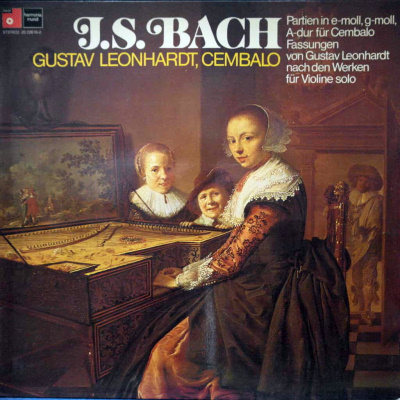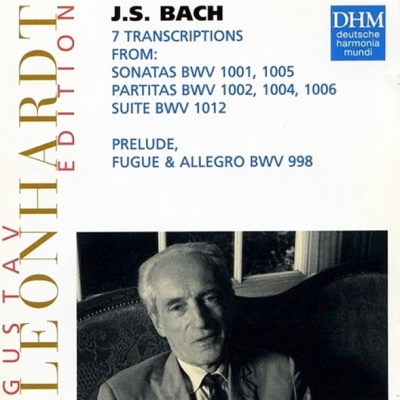 |
|
1 LP -
20 22618-2 - (p) 1975
|
 |
| 2 CDs -
74321 32320 2 - (c) 1995 |
|
PARTIEN FÜR
CEMBALO - FASSUNGEN VON GUSTAV LEONHARDT
NACH DEN WERKEN FÜR VIOLINE SOLO
|
|
|
|
|
|
|
|
| Johann Sebastian
BACH (1685-1750) |
Partia
in A-dur für Cembalo - nach der Violinsolopartia in E-dur,
BWV 1006 |
|
15' 05" |
|
|
- Preludio
|
3' 59" |
|
A1 |
|
- Loure
|
3' 09" |
|
A2 |
|
- Gavotte en
Rondeau |
3' 00" |
|
A3 |
|
- Menuet |
3' 09" |
|
A4 |
|
- Bourrée |
0' 47" |
|
A5 |
|
- Gigue |
1' 01" |
|
A6 |
|
Partia
in g-moll für Cembalo - nach der Violinsolopartia in
d-moll, BWV 1004 |
|
21' 53" |
|
|
- Allemanda |
2' 47" |
|
A7 |
|
- Corrente
|
1' 23" |
|
A8 |
|
- Sarabanda
|
3' 30" |
|
A9 |
|
- Giga |
2'
00"
|
|
A10 |
|
- Ciaccona |
12' 13" |
|
B1 |
|
Partia
in e-moll für Cembalo - nach der Violinsolopartia in
h-moll, BWV 1002 |
|
15' 30" |
|
|
- Allemande
· Double
|
4' 52" |
|
B2 |
|
- Courante ·
Double
|
3' 42" |
|
B3 |
|
- Sarabande
· Double
|
3' 54" |
|
B4 |
|
- Tempo di
Borea · Double |
3' 02" |
|
B5 |
|
|
|
|
|
Gustav LEONHARDT,
Cembalo (William Dowd, Paris
1975, nach Blanchet, Paris um
1730)
|
|
|
|
|
|
Luogo
e data di registrazione |
|
Cedernsaal, Schloß
Kirchheim (Germany) - giugno 1975
|
|
|
Registrazione: live
/ studio |
|
studio |
|
|
Recording
Supervision |
|
Dr. Thomas Gallia |
Paul Dery
|
|
|
Engineer |
|
Sonart, Milano
|
|
|
Prima Edizione LP |
|
Harmonia Mundi (Basf)
| 20 22618-2 | 1 LP - durata 52'
28" | (p) 1975
|
|
|
Edizione CD |
|
Deutsche
Harmonia Mundi | LC 0761 |
74321 32320 2 | 2 CDs -
durata 51' 11" - 60' 08" |
(c) 1995 | ADD/DDD
|
|
|
Cover Art
|
|
"Frau am Cembalo" by
Jan Miense Molenaer (1609-1668).
|
|
|
Note |
|
L'edizione in doppio
CD contiene anche la pubblicazione
del 1985 (1C 067-16 9525 1) ed il
Preludio, Fuga e Allegro BWV 998
contenuto nella pubblicazione (HMS
30 868) del 1968. |
|
|
|
|
The keyboard
player has always had the
pleasure of being to play by
himself what others have to
form an ensemble to play.
And this is not only his
pleasure but also his gride.
And so, in addition to
"original" pieces, the
history of music is filled
with a host of
"arrangements": theyy range
from transcriptions of
popular vocal and
instrumental pieces in the
sixteenth century to piano
scores of symphonies and
operas in the ninetenth.
When, as was often the case,
a great composer turned his
hand to making an
arrangement, the result was
a real keyboard work in its
own right - indeed, a
composer was not
infrequently his own
arranger (Byrd, Bach,
Stravinsky, etc.)! What
makes all these arrangements
enjoyable even today is the
undisturbed stylistic
relationship
between the original
and the arrangement. Many
people are finding that the
only arrangements which are
not enjoyable are those
whose idiom or sound is
alien.
In his earlier years, Bach
set concerti by his
contemporaries Vivaldi,
Johann Ernst von
Sachsen-Weimar, Marcello and
Telemann for a keyboard
instrument, and in later
years he released his own
exorbitantly difficult works
for solo violin from their
isolation by transferring
them - in either improvised
or notated form - to the
keyboard.
His pupil Agricola reports
as late as 1773: "Their
author himself played them
frequently on the
clavichord, and added as
much harmony to them as he
found mecessary". And Adlung
observed in 1758: "[3
sonatas and 3 partitas]
however are very suitable
for playing on the clavier".
Nowadays we have the
complete A minor sonata in a
keyboard version in his hand
(at least I see non reason
for believing that
thoroughly Bachian piece to
have been the work of a
pupil). The organ version of
the G minor fugue (complete
with a new Praeludium) could
similarly be his own work
the bold arrangement of the
first movement of the C
major sonata should probably
be asribed to one of his
pupils (it may perhaps be
the work of Altnikol), while
the E major partita survives
in a keyboard version made
by a somewhat indifferent
player. Bach himself
arranged the first movement
of this work as the
introduction to Cantata No.
29 for organ obbligato with
accompanying trumpets,
timpani, oboes an strings.
And how much more may have
been lost?
I think that Bach would have
forgiven me for the fact
that I have set myself to
making arrangements of his
works; whether he would have
forgiven the way in which I
have done it, remains of
cours a moot point. There is
at least a strong incentive
in putting oneself to the
test with the question of
how far it is possible int a
twentieth-century player to
put himself back in thought
and freeling into Bach's
keyboard style.
The deeper stimules to make
these arrangements, of
course, lies in the unique
beauty of those works which
we hear on the violin only
too infrequently.
I added only "such harmony
as was necessary" and hope,
with the harpsichord sound
with which Bach was
familiar, to have matched
his idiom in such a way that
no alien feeling is
apparent.
The transposition downwards
by a fith (or a fourth)
corresponds to Bach's own
practice; in this way, the
harpsichord keybiard's
compass (GG-d") is fully and
naturally exploited.
Gustav
Leonhardt
|
  |
|
|